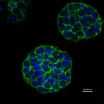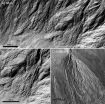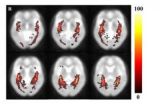(Press-News.org) Drexel's Wei Sun, PhD, Albert Soffa chair professor in the College of Engineering, has devised a method for 3D printing tumors that could soon be taking cancer research out of the petri dish.
Using a mixture of cervical cancer cells and a hydrogel substance that resembles an ointment balm, Sun can print out a tumor model that can be used for studying their growth and response to treatment. This living model will give cancer researchers a better look at how tumors behave and a more accurate measure of how they respond to treatment.
"This is the first time to report that one can build a 3D in vitro tumor model through 3D Printing technology," said Sun, the director of Drexel's research center at the Shanghai Advanced Research Institute. "This may lead to a new paradigm for cancer research and for individual cancer therapies. We have developed a technological platform and would like to work with biologists and pathologists to encourage them to use the developed platform for 3D biology and disease studies."
While researchers have been able to make cell models and tissues using rapid prototyping methods for some time, Sun's lab, is the first to produce a living 3D tumor model through additive manufacturing –also known as 3D printing. In a study published in the journal Biofabrication in April, Sun reports a procedure his team developed for growing research-grade models of cervical cancer tumors.
Cancer researchers are aware that working with two-dimensional samples comes with inherent limitations. For example, tumors in the body have a much different surface area, shape and cellular composition than samples grown in a lab, thus data from tests of cancer treatments will differ from the reaction of an actual tumor to the drugs. But until now, these in vitro cell cultures were their best option.
"Two-dimensional cell culture models are traditionally used for biology study and drug screening," Sun said. "However, two-dimensional culture models can not represent true 3D physiological tissues so it lacks the microenvironment characteristics of natural 3D tissues in vivo. This inherent inadequacy leads to shortcomings in cancer research and anti-tumor drug development. On the other hand, 3D tumor models can represent true tumor 3D pathological organizations and will lead to a new paradigm for cancer study."
As part of the National Science Foundation-funded study, Sun tested his tumor model against a two-dimensional culture sample using a common anti-cancer drug. Sun's 3D printed tumors showed more resistance to chemical treatment than the same cancer cells grown in a petri dish –an illustration of the disparity that exists between test results and success rates of cancer treatments.
Sun, who is a mechanical engineering researcher with a focus on biomodeling, designed and patented a special 3D printer in 2002 so his lab, the Drexel Biofabrication Laboratory, could make tissue samples and bone scaffolds as part of their research. As his work progressed, it became apparent that the next step was to figure out a way to print living 3D models of tissues and organs.
With a significant background in the extrusion, or additive, modeling process, Sun and his team were able to control for the main variables: diameter of nozzle, speed and pressure of extrusion, pattern and size of deposition, and viscosity and temperature of substrate materials.
For the undertaking, Sun's team, composed of researchers at Drexel University, Tsinghua University in Beijing, China, and Drexel-Shanghai Advanced Research Center in Shanghai, China, used a multi-nozzle printer to extrude a gelatinous mixture of hydrogels and living cervical cancer cells. The result was a cellular deposition in which 90 percent of the cancer cells survived the process and within eight days had grown into spheroid-shaped tumors.
"The keys to keeping the cells alive were controlling the temperature of the nozzle and using a hearty strain of cancer cells," Sun said. "We chose the Hela cell, which is a robust form of cervical cancer that has been used in research for many years. Because of this, we had a good idea as to how it would behave under certain conditions. This allowed us to control the variables of the extrusion process until we were able to successfully create a model."
Sun's team plans to continue its research in hopes of creating tumors that are even more similar to those that grow in the body. They will work to print tumors composed of multiple different cells –a trait often found in those removed from cancer patients. In addition, the group is working on ways to attach the models to tissues and vasculature that they've printed, which would recreate the way tumors grow in their bodily habitat.
"We will try to understand the cell-cell and cell-substrate communication and immune responses for the printed tumor-like models," Sun said. "Our goal is to take this tumor-like model and make it into a more of an in vivo simulation. And to apply it to study the development, invasion and metastasis of cancer, to test the efficacy and safety of new cancer drugs, as well as the specific therapy for individual cancer patient."
INFORMATION: END
3D printing cancer tumors
Engineering breakthrough will allow cancer researchers to create living tumors
2014-04-25
ELSE PRESS RELEASES FROM THIS DATE:
Study reaffirms soy-dairy protein blend increases muscle mass
2014-04-25
A new study published online in the Journal of Applied Physiology shows additional benefits of consuming a blend of soy and dairy proteins after resistance exercise for building muscle mass. Researchers from the University of Texas Medical Branch found that using a protein blend of soy, casein and whey post-workout prolongs the delivery of select amino acids to the muscle for an hour longer than using whey alone. It also shows a prolonged increase in amino acid net balance across the leg muscle during early post-exercise recovery, suggesting prolonged muscle building. ...
Nitrogen pollution, climate and land use: Why what we eat matters
2014-04-25
A new report quantifies for the first time how much our food choices affect pollutant nitrogen emissions, climate change and land-use across Europe.
The executive summary of the European Nitrogen Assessment Special Report on Nitrogen and Food, 'Nitrogen on the Table', was released today (Friday 25 April 2014). The Special report provides an assessment of what would happen if Europe were to decrease its consumption of meat and dairy products. It shows how much cutting down on meat and dairy in our diets would reduce nitrogen air and water pollution, and greenhouse gas ...
A civil war inside our cells: Scientists show how our bodies fight off 'jumping genes'
2014-04-25
ANN ARBOR, Mich. — There's a civil war going on inside every one of the 37 trillion cells in your body. Now, University of Michigan scientists have uncovered how your cells keep this war from causing too much collateral damage.
On one side of the battle: your "regular" DNA, which provides the day-to-day instructions for life. On the other side: tiny bits of rogue DNA that hide like spies between genes in your own DNA. From time to time, these rogue bits of DNA spin off a copy of themselves and "jump" to another DNA location – often causing harmful mutations when they ...
Traces of recent water on Mars
2014-04-25
The southern hemisphere of Mars is home to a crater that contains very well-preserved gullies and debris flow deposits. The geomorphological attributes of these landforms provide evidence that they were formed by the action of liquid water in geologically recent time.
Evidence of liquid water
When sediment on a slope becomes saturated with water, the mixture may become too heavy to remain in place, leading to a flow of debris and water as a single-phase unit. This is called a debris flow. Debris flows on Earth often cause significant material destruction and even human ...
Tsetse fly genetic code sequenced
2014-04-25
Scientists at the University of Liverpool have been part of a ten-year project which has successfully sequenced the genetic code of the tsetse fly – making major advances in disease control possible.
Tsetse flies are unique to Africa and can infect people bitten by them with sleeping sickness, a disease which damages the nervous system and is fatal if untreated. This kills over 250,000 people each year.
Traditional methods of control such as releasing sterile males, trapping and pesticide spraying are expensive and difficult to implement. Sleeping sickness can also ...
Quantitative volumetric analysis of the optic radiation in the normal human brain
2014-04-25
The optic radiation is a dense fiber tract that emerges from the lateral geniculate nucleus and continues to the occipital visual cortex. Especially, the optic radiation is an important fiber structure that conveys visual information from the lateral geniculate nucleus to the primary visual cortex in the occipital lobe. Current studies have focused on the anatomical characteristics of optic radiation fiber tracts in individual brains and on comparisons of the anatomical characteristics of the optic radiation fiber tracts between patient and control groups. Therefore, no ...
Climate change: Don't wait until you can feel it
2014-04-25
Washington, D.C.— Despite overwhelming scientific evidence for the impending dangers of human-made climate change, policy decisions leading to substantial emissions reduction have been slow. New work from Carnegie's Katharine Ricke and Ken Caldeira focuses on the intersection between personal and global impacts. They find that even as extreme weather events influence those who experience them to support policy to address climate change, waiting for the majority of people to live through such conditions firsthand could delay meaningful action by decades. Their findings ...
Reconstructed ancient ocean reveals secrets about the origin of life
2014-04-25
HEIDELBERG, 25 April 2014 – Researchers from the University of Cambridge have published details about how the first organisms on Earth could have become metabolically active. The results, which are reported in the journal Molecular Systems Biology, permit scientists to speculate how primitive cells learned to synthesize their organic components – the molecules that form RNA, lipids and amino acids. The findings also suggest an order for the sequence of events that led to the origin of life.
A reconstruction of Earth's earliest ocean in the laboratory revealed the spontaneous ...
Metabolism may have started in our early oceans before the origin of life
2014-04-25
The chemical reactions behind the formation of common metabolites in modern organisms could have formed spontaneously in the earth's early oceans, questioning the events thought to have led to the origin of life.
In new research funded by the Wellcome Trust, researchers at the University of Cambridge reconstructed the chemical make-up of the earth's earliest ocean in the laboratory. The team found the spontaneous occurrence of reaction sequences which in modern organisms enable the formation of molecules essential for the synthesis of metabolites such as amino acids, ...
Apps, Touch Tablets Bringing Mobility to Chemical Research Industry
2014-04-25
The formula for success in the chemical research industry is beginning to take shape outside of the traditional laboratory setting.
Touch-enabled software and tablets are transforming chemical researchers' workflows, bringing time-savings and mobile capability to professionals who are used to desktop computers and the pen-and-paper mentality.
For example, the updated Mobile Reagents scientific app from Eidogen-Sertanty now offers a Windows* 8 version for touch devices built on Intel architecture, and allows mobile access to more than 17 million chemical product variations ...
LAST 30 PRESS RELEASES:
Fathers’ microplastic exposure tied to their children’s metabolic problems
Research validates laboratory model for studying high-grade serous ovarian cancer
SIR 2026 delivers transformative breakthroughs in minimally invasive medicine to improve patient care
Stem Cell Reports most downloaded papers of 2025 highlight the breadth and impact of stem cell research
Oxford-led study estimates NHS spends around 3% of its primary and secondary care budget on the health impacts of heat and cold in England
A researcher’s long quest leads to a smart composite breakthrough
Urban wild bees act as “microbial sensors” of city health.
New study finds where you live affects recovery after a hip fracture
Forecasting the impact of fully automated vehicle adoption on US road traffic injuries
Alcohol-related hospitalizations from 2016 to 2022
Semaglutide and hospitalizations in patients with obesity and established cardiovascular disease
Researchers ‘listen in’ to embryo-mother interactions during implantation using a culture system replicating the womb lining
How changing your diet could help save the world
How to make AI truly scalable and reliable for real-time traffic assignment?
Beyond fragmented markets: A new framework for efficient and stable ride-pooling
Can shape priors make road perception more reliable for autonomous driving?
AI tracks nearly 100 years of aging research, revealing key trends and gaps
Innovative techniques enable Italy’s first imaging of individual trapped atoms
KIER successfully develops Korea-made “calibration thermoelectric module” for measuring thermoelectric device performance
Diversifying US Midwest farming for stability and resilience
Emphasizing immigrants’ deservingness shifts attitudes
Japanese eels, climate change, and river temperature
Pusan National University researchers discover faster, smarter heat treatment for lightweight magnesium metals
China’s 2024 Gastroenterology Report: marked progress in endoscopy quality and disease management
Pusan National University researchers uncover scalable method for ultrahigh-resolution quantum dot displays
Researchers use robotics to find potential new antibiotic among hundreds of metal complexes
Gut bacteria changes at the earliest stages of inflammatory bowel disease
Scientists develop new way to “listen in” on the brain’s hidden language
Brain research: “Pulse generators” grow and shrink as memories are formed
For teens, any cannabis use may have impact on emotional health, academic performance
[Press-News.org] 3D printing cancer tumorsEngineering breakthrough will allow cancer researchers to create living tumors




